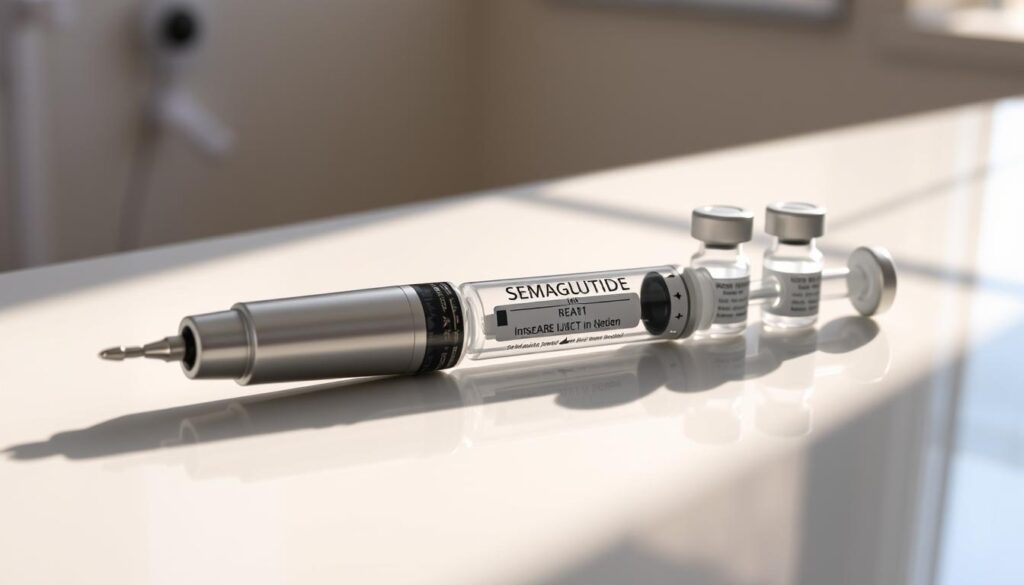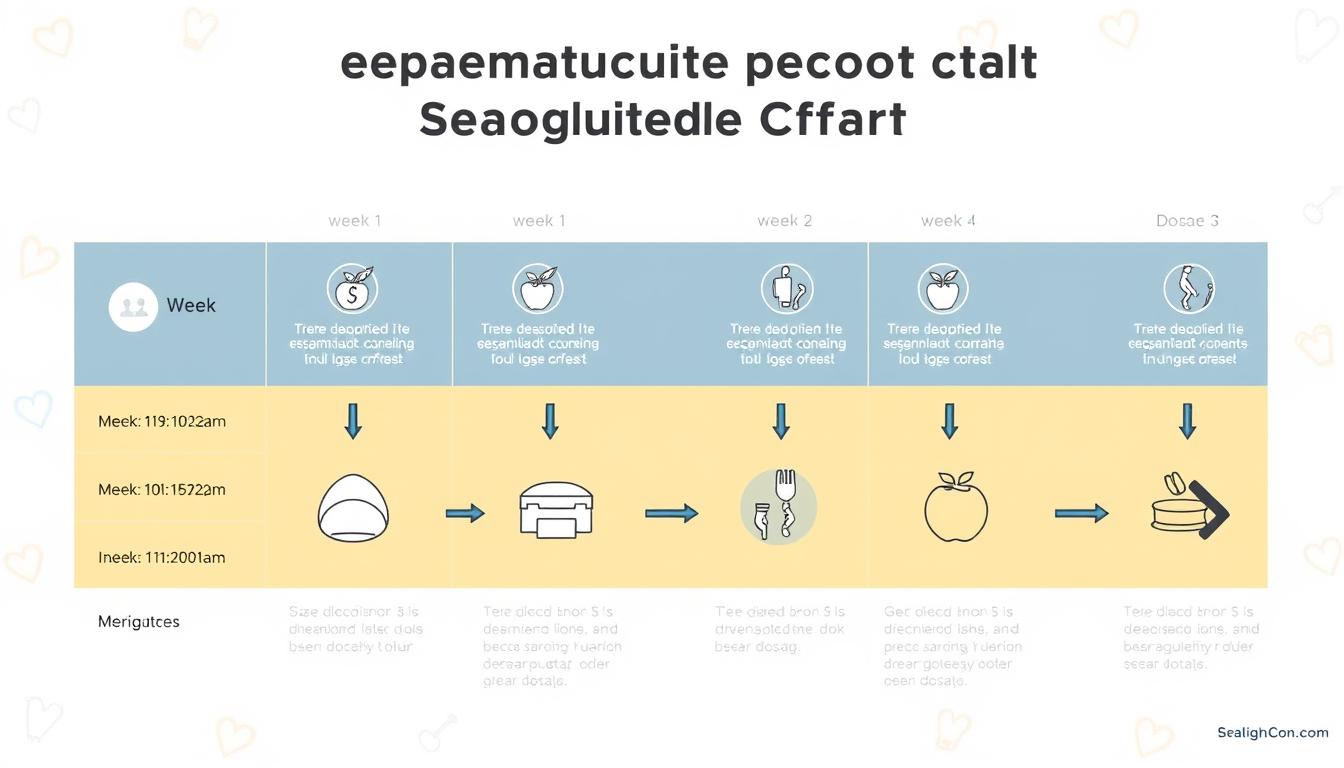Semaglutide Weight Loss Dosage Chart: Weekly Guide
“The secret of getting ahead is getting started.” – Mark Twain
Starting a weight loss journey can seem overwhelming. But with the right tools and guidance, it becomes easier. Semaglutide, a new GLP-1 receptor agonist, is a promising choice for effective weight management. This guide will help you understand the semaglutide weight loss dosage chart. It will be your weekly roadmap to a healthier you.
Table of Contents
Understanding Semaglutide for Weight Management
Semaglutide is a new medicine that helps with weight control. It works like a hormone in our body called GLP-1. This hormone helps control hunger and blood sugar levels. So, semaglutide is a powerful tool against obesity and related health problems.
Benefits of Semaglutide Treatment
Studies show semaglutide can help adults lose a lot of weight. It’s for people with a BMI of 30 or more. Or those with a BMI of 27 and health issues related to weight.
People taking higher doses lost up to 15% of their body weight in 40 weeks. This is a big deal for weight loss.
It also helps with heart health and blood sugar control in people with type 2 diabetes. This makes it great for those with both obesity and diabetes.
FDA Approval and Clinical Studies
The FDA has approved semaglutide for weight management. The approved versions, like Wegovy and Ozempic, have been tested a lot. These tests show semaglutide is safe and works well.
These studies prove semaglutide helps people lose weight and improve heart health. It’s a big win for those trying to lose weight.
In short, semaglutide is a great choice for weight loss. It’s safe, effective, and approved by the FDA. It’s a good option for those who can’t lose weight on their own.
Different Forms of Semaglutide Medications
Semaglutide is a strong GLP-1 receptor agonist. It comes in many forms for weight management and type 2 diabetes treatment. You can find Wegovy, the diabetes drug Ozempic, the tablet Rybelsus, and compounded semaglutide.
Wegovy is the only FDA-approved semaglutide for weight management. It’s given as a weekly subcutaneous injection. It has shown great results in weight loss studies. On the other hand, Ozempic mainly treats type 2 diabetes but is sometimes used for weight loss too. Rybelsus is an oral tablet for diabetes treatment.
Compounded semaglutide is made by pharmacies and can be tailored to your needs. It might be cheaper than the branded versions. But, it’s not FDA-approved, so its safety and effectiveness can differ. Always talk to a doctor before starting any semaglutide medication. They can help choose the right one for you.
| Medication | Indication | Administration | FDA Approval |
|---|---|---|---|
| Wegovy | Chronic weight management | Subcutaneous injection once weekly | Yes |
| Ozempic | Type 2 diabetes (used off-label for weight loss) | Subcutaneous injection once weekly | Yes |
| Rybelsus | Type 2 diabetes | Oral tablet | Yes |
| Compounded semaglutide | Weight management, type 2 diabetes | Varies | No |
In summary, there are many semaglutide options for treatment. But, it’s important to talk to a doctor to find the best one for you.
Semaglutide Weight Loss Dosage Chart
Semaglutide is found in medications like Wegovy and Ozempic. It’s given in a gradual schedule to work well and avoid side effects. This way, your body gets used to it slowly, helping you lose weight for good.
Initial Dosing Phase (Weeks 1-4)
The journey starts with a small dose of 0.25 mg once a week for four weeks. This first step helps your body adjust, lowering the chance of stomach problems like nausea.
Titration Schedule (Weeks 5-12)
After the first four weeks, the dose goes up to get the best results. Here’s how it increases:
- Weeks 5-8: 0.5 mg once weekly
- Weeks 9-12: 1.0 mg once weekly
Maintenance Dose (Week 13+)
After the increase, you’ll get to the maintenance dose. This is usually 1.7 mg or 2.4 mg for Wegovy, or 1.0 mg or 2.0 mg for Ozempic. Your doctor will adjust this based on how you react to the drug.
Higher doses can mean more weight loss. But your doctor will find the right amount for you and your goals.
The dosage schedule is made to help your body adjust slowly. It supports your long-term weight goals. Always follow your doctor’s advice for the best results.
Proper Administration and Storage Guidelines

Using semaglutide, found in Ozempic and Wegovy, needs careful steps. It’s injected just under the skin in the stomach, upper arm, or thigh. Make sure to change the spot every week to avoid soreness or bruises.
Take semaglutide on the same day each week, with or without food. For Ozempic or Wegovy pens, wait for the yellow bar to stop or count to six before pulling out the needle. This ensures you get the right dose.
| Semaglutide Storage | Unopened Pens | Opened Pens |
|---|---|---|
| Temperature | Refrigerate (36°F to 46°F or 2°C to 8°C) | Room temperature (59°F to 86°F or 15°C to 30°C) |
| Maximum Storage Time | Until expiration date | Up to 28 days (Wegovy) or 56 days (Ozempic) |
Keeping semaglutide right is key for its safety and effectiveness. Unopened pens go in the fridge. Opened ones stay at room temperature for up to 28 days for Wegovy or 56 days for Ozempic. Don’t let it get too hot or cold.
By following these steps, you get the most out of semaglutide. This helps avoid problems or lessening its effect.https://www.naturalpurecare.com/natural-remedies-for-glowing-skin/
Safety Considerations and Precautions
It’s important to know the safety tips and precautions for semaglutide. This weight management drug is usually safe, but there are things to watch out for before starting it.
Contraindications
Semaglutide is not for people with a history of medullary thyroid cancer or Multiple Endocrine Neoplasia Type 2 (MEN 2). It’s also not recommended for pregnant or breastfeeding women. This is because it could be risky for the baby or the nursing infant.
Medical History Requirements
Your doctor will look at your medical history before starting semaglutide. If you have kidney, liver, or pancreas issues, you’ll need to be closely watched. People with type 2 diabetes should keep an eye on their blood sugar while taking this drug.
Monitoring Requirements
Regular doctor visits are key when taking semaglutide. Your doctor will check how well the treatment is working and watch for side effects. This might include blood tests and physical exams to keep you safe and help you get the best results.
“Semaglutide is a powerful tool for weight management, but it’s crucial to follow the safety guidelines and work closely with your healthcare provider to ensure a safe and successful treatment journey.”
Knowing the safety tips and precautions for semaglutide helps you decide if it’s right for you. It also helps you stay safe and healthy while taking the drug.
Managing Common Side Effects
Using semaglutide for weight loss can have some side effects. But, many can be managed with simple steps. Common issues include nausea, vomiting, diarrhea, constipation, and stomach pain. To lessen these, eat small, light meals and avoid greasy foods. Drinking plenty of water is also key, as dehydration can happen from severe nausea and vomiting.
Less common but serious side effects include pancreatitis, gallbladder issues, and heart rate changes. If you have severe or ongoing side effects, like intense stomach pain, fever, yellow skin, or mood changes, get medical help right away.
Watch for signs of thyroid C-Cell tumors, like trouble swallowing, hoarseness, neck swelling, or breathing issues. Also, diabetic retinopathy might get worse, especially if you have a history of it and type 2 diabetes.
Most symptoms get better as your body gets used to the drug. But, if side effects don’t go away or get worse, talk to your doctor. They can help manage the side effects and keep you safe while taking semaglutide.
| Common Side Effects | Severe Side Effects |
|---|---|
|
|
While semaglutide helps with weight management, it’s key to work closely with your doctor. This way, you can watch for side effects and handle them well. Being proactive and open with your doctor helps you get the most from the medication while keeping your health and safety first.
Drug Interactions and Considerations
When you take semaglutide, watch out for drug interactions. Semaglutide is a GLP-1 receptor agonist. It can affect how other drugs work by changing how they are absorbed or their effectiveness.
Medications to Avoid
Semaglutide might not get along with insulin, sulfonylureas, and drugs with narrow therapeutic windows. It can slow down how fast your stomach empties. This might change how other oral drugs are absorbed. If you take thyroid hormone meds, talk to your doctor about when to take them to avoid absorption issues.
Alcohol Consumption Guidelines
Drinking alcohol can mess with your blood sugar levels. This is something to think about when you’re on semaglutide. Always check with your doctor about how much alcohol is okay to drink. Drinking too much can lead to more side effects or problems.
| Medication | Potential Interaction | Precautions |
|---|---|---|
| Insulin | Potential for increased risk of hypoglycemia | Monitor blood sugar levels closely and adjust insulin dosage as needed |
| Sulfonylureas | Potential for increased risk of hypoglycemia | Monitor blood sugar levels closely and adjust sulfonylurea dosage as needed |
| Medications with narrow therapeutic windows | Delayed gastric emptying may affect absorption | Closely monitor the effectiveness of these medications and adjust dosages as necessary |
| Thyroid hormone medications | Delayed gastric emptying may affect absorption | Adjust the timing of thyroid hormone medications to ensure proper absorption |
| Alcohol | Can affect blood sugar levels | Consult your healthcare provider for specific guidelines on alcohol consumption while using semaglutide |
Knowing about semaglutide drug interactions helps you work with your doctor. This ensures your treatment is safe and effective. It also means you can manage your health better while using this weight management drug. Remember, being careful about semaglutide and alcohol interactions is key to your overall health.
Comparing Wegovy, Ozempic, and Compounded Semaglutide

When it comes to managing weight, semaglutide-based meds are popular. But, it’s key to know the differences between Wegovy, Ozempic, and compounded semaglutide.
Wegovy is approved by the FDA for weight loss. Ozempic is for type 2 diabetes. Both have semaglutide but differ in dosage and use.
Compounded semaglutide offers customization and might be cheaper. Yet, it hasn’t been as thoroughly tested by the FDA as Wegovy and Ozempic. While side effects and effectiveness are similar, everyone reacts differently.
| Medication | Indication | Dosing Schedule | FDA Approval |
|---|---|---|---|
| Wegovy | Weight Loss | Once Weekly | Yes |
| Ozempic | Type 2 Diabetes | Once Weekly | Yes |
| Compounded Semaglutide | Weight Loss, Type 2 Diabetes | Customized | No |
While compounded semaglutide might have benefits, it hasn’t been as thoroughly tested as Wegovy and Ozempic. If you’re thinking about it, talk to your doctor about the risks and benefits.
“Oral semaglutide has not been FDA regulated for safety, effectiveness, or quality when compounded by physicians.”
In summary, knowing the differences between Wegovy, Ozempic, and compounded semaglutide is important. It helps you choose the best option for weight management or diabetes treatment. Always talk to your doctor to find the right choice for you.
Maximizing Weight Loss Results with Semaglutide
To get the best results from semaglutide, you need to use it with a healthy lifestyle. Semaglutide is a medicine that helps with weight loss. It works best when you eat fewer calories and move more.
Stick to the dose your doctor tells you to take. Start with a small dose and slowly increase it. Drinking plenty of water and managing side effects like nausea or constipation will help you stay on track.
- Eat a balanced diet with fewer calories.
- Do regular exercise like walking, swimming, or lifting weights.
- Go to your doctor’s appointments to check on your progress and adjust your treatment if needed.
Using semaglutide with these lifestyle changes can help you lose weight and get healthier. Remember, being consistent and patient is important for the best results.
| Semaglutide Weight Loss Tips | Optimizing Semaglutide Treatment |
|---|---|
|
|
“Consistency and patience are key when optimizing your semaglutide treatment for weight management.”
Important Medical Monitoring During Treatment
Starting a semaglutide weight loss journey means you need to watch your health closely. Regular visits to the doctor are key to keeping your treatment safe and working well. You’ll need to stay in touch with your healthcare provider to track your progress and handle any issues that come up.
Tracking your weight loss is a big part of medical monitoring with semaglutide. Your doctor will keep an eye on how much weight you lose. They might also check your body composition to make sure you’re losing fat and gaining muscle in a healthy way.
Your doctor will also watch your blood sugar levels, especially if you have diabetes. Semaglutide helps control blood sugar, but it’s important to check levels regularly to avoid problems.
It’s also important to check for side effects like gallbladder issues, pancreatitis, or kidney problems. Your doctor might suggest extra tests based on your health history and how your treatment is going.
If you’ve had diabetic retinopathy, you’ll need to get your eyes checked often. This is because semaglutide could affect your eye health in some people.
Keeping in touch with your doctor and following their advice is vital for a successful semaglutide treatment. By working together with your healthcare team, you can safely and effectively lose weight.
“Consistent medical monitoring is the key to a successful semaglutide weight loss journey. Together, we can ensure your safety and maximize your results.”
Conclusion
Semaglutide is a game-changer for weight loss. It works well when part of a full treatment plan. Knowing how to use it, its side effects, and how it helps with weight loss is key.
Seeing your doctor regularly and making healthy lifestyle choices can boost semaglutide’s effects. Talking to your doctor is important to see if semaglutide is right for you. They can help tailor the treatment to fit your needs.
Using semaglutide as part of a complete weight management plan can lead to amazing results. It can greatly improve your health and make you feel better. Start using semaglutide today for a healthier, happier life.
FAQ
What is the typical dosing schedule for semaglutide?
How does semaglutide work for weight loss and diabetes management?
What are the different forms of semaglutide available?
How should semaglutide be administered and stored?
What are the safety considerations and precautions for semaglutide?
What are the common side effects of semaglutide?
How does semaglutide interact with other medications?
What are the key differences between Wegovy, Ozempic, and compounded semaglutide?
How can I maximize weight loss results with semaglutide?
What medical monitoring is required during semaglutide treatment?
Source Links
- What Is The Lowest Dose of Semaglutide (With Chart) – https://www.tryeden.com/post/what-is-the-lowest-dose-of-semaglutide?srsltid=AfmBOoqx5RuKNRr5ziz6n0eLAmIxhmolhVC_XajGnKyDT3geE_TbMRm0
- Compounded Semaglutide With B12: Dosage Chart & Guidelines – https://www.tryeden.com/post/compounded-semaglutide-with-b12-dosage-chart?srsltid=AfmBOopdAwmO7A1YREHVzYcgegUbIDN4_qnGGjHUSJOeUIrwUhPtfg29
- Wegovy Dosage Guide for Weight Loss | Wegovy Schedule – https://www.joinvoy.com/blog/wegovy-doses-for-weight-loss
- Semaglutide Weight Loss Dosage Chart — What To Take To Lose – https://www.helloklarity.com/post/semaglutide-weight-loss-dosage/
- What Is The Lowest Dose of Semaglutide (With Chart) – https://www.tryeden.com/post/what-is-the-lowest-dose-of-semaglutide?srsltid=AfmBOorj5i120dSghREYRyzbwtbR-jKW4–VSHIJy1M3PP8EMNpHpU8E
- What Is The Lowest Dose of Semaglutide (With Chart) – https://www.tryeden.com/post/what-is-the-lowest-dose-of-semaglutide?srsltid=AfmBOop-zm9VI0FNpCQ4Y7y29pXw5J63GJOWS0z865nFEg1tMDRSh0kb
- Wegovy Dosage Guide: Which Semaglutide Dosage Do I Need? – https://www.ukmeds.co.uk/blog/wegovy-dosage-guide
- Semaglutide and Pyridoxine Dosage Guidelines – https://www.tryeden.com/post/semaglutide-pyridoxine-dosage?srsltid=AfmBOorQ_Zy1do427-wC7p27Zvbi-Gof9yGnKpy0nxeDh_X4e5D7HxHu
- Semaglutide Weight Loss Dosage Chart: Mapping Out Dosage for Optimal Results – https://www.ahara.com/learn/semaglutide-weight-loss-dosage-chart
- What Is The Lowest Dose of Semaglutide (With Chart) – https://www.tryeden.com/post/what-is-the-lowest-dose-of-semaglutide?srsltid=AfmBOop5YJ4134iKeixhUhU6YwyY5wVBcFtmDjl5vFMx1vD5IoFNw-BU
- How to Inject Semaglutide for Weight Loss | Ro – https://ro.co/weight-loss/how-to-inject-semaglutide/
- What Is The Lowest Dose of Semaglutide (With Chart) – https://www.tryeden.com/post/what-is-the-lowest-dose-of-semaglutide?srsltid=AfmBOoqSVZC-a-g3KHMIPzPeZ0ccdOQl5hfEw5J_S0awpBWpae7aYYCV
- Biweekly Semaglutide: Alternative Dosing Information – https://www.tryeden.com/post/semaglutide-biweekly-dosing?srsltid=AfmBOoqRMYOmrbh9K65lKvfR6cFFxXlcIByj7wbE2mGmDbZYiIpYaPyZ
- Semaglutide Injections and Food: What to Eat and What to Avoid | Juniper – https://www.myjuniper.co.uk/articles/ozempic-foods-to-avoid
- How Does Semaglutide Work? Mechanism, Benefits & Effects | Ro – https://ro.co/weight-loss/how-does-semaglutide-work/
- What Is The Lowest Dose of Semaglutide (With Chart) – https://www.tryeden.com/post/what-is-the-lowest-dose-of-semaglutide?srsltid=AfmBOopFjKZwNgujYnMazNn2I_ivbj5k-ZXqNP5Svzaps431xqSGAtdt
- Manage Side Effects of Injectable Semaglutide | Eden – https://www.tryeden.com/post/how-to-manage-side-effects-of-injectable-semaglutide?srsltid=AfmBOoqgaHYbRrJCkZuL9zecd2VGt1c-cMWnsVlaFUoOa_lG919HAn4v
- What Is The Lowest Dose of Semaglutide (With Chart) – https://www.tryeden.com/post/what-is-the-lowest-dose-of-semaglutide?srsltid=AfmBOoq-vk1EwmWpoDzFoYv0lvvqqJHlw02o8cuGJk69WmXP7Tbzf4H2
- Compounded Semaglutide With B12: Dosage Chart & Guidelines – https://www.tryeden.com/post/compounded-semaglutide-with-b12-dosage-chart?srsltid=AfmBOor0WXGSlvS3kqwWf90qdJGayn-H1tFYjU4BpO8DCnBtAKjBhOS9
- Semaglutide (Ozempic, Wegovy) and birth control: What to know – https://www.medicalnewstoday.com/articles/semaglutide-and-birth-control
- Biweekly Semaglutide: Alternative Dosing Information – https://www.tryeden.com/post/semaglutide-biweekly-dosing?srsltid=AfmBOooIma13RlTCu5EZ4LQGNHVvR4A5cORV0pqnMgvaCBt80EvFje8h
- Semaglutide For Weight Loss: Doses, Types & Where To Buy – https://www.tryeden.com/post/semaglutide-for-weight-loss?srsltid=AfmBOorHay_parXpzkm3aHva3Fiv5EuQRZn9F6Bq5_D49z3lUfhNf_Ao
- What Is The Lowest Dose of Semaglutide (With Chart) – https://www.tryeden.com/post/what-is-the-lowest-dose-of-semaglutide?srsltid=AfmBOoqRCteh72_CCFtVUscyvcNdlat6FUGoM5Gmcwg6U1yJhQtOcWt5
- Semaglutide and Pyridoxine Dosage Guidelines – https://www.tryeden.com/post/semaglutide-pyridoxine-dosage?srsltid=AfmBOoq0nIJwWbWiyN0Aak2gGzLhmiZM1_V_IWO7vEgdnc2-tBN1DK3B
- Tirzepatide & Semaglutide Weight Loss Injections | Medford & Grants Pass – https://www.admireaesthetics.com/semaglutide-weight-loss/
- GLP-1 drugs for weight loss: Do they lead to muscle mass loss? – https://www.medicalnewstoday.com/articles/how-to-preserve-muscle-mass-on-weight-loss-drugs-like-wegovy
- Semaglutide Dosage: How To Determine The Right Dose | Levity – https://www.joinlevity.com/posts/semaglutide-doses
- Semaglutide Weight Loss Dosage Chart – https://muscleandbrawn.com/peptides/semaglutide-weight-loss-dosage-chart/
- Management of obesity with semaglutide or metformin in patients with antipsychotic-induced weight gain (MOSA): a non-randomised open-label pilot study – BMC Psychiatry – https://bmcpsychiatry.biomedcentral.com/articles/10.1186/s12888-024-06317-7







